

Loading Section...
During the bathing festival (Deva Snana Purnima) the Deities of the temple have a bath with 108 pots of cold water to fight the heat of summer. After this royal bath ceremony the three Deities are sick (suffering from fever), and return to the temple in the Pahandi procession. The Deities do not go back to the Garbha Griha (inner sanctum) but are placed on a special place called 'Anasara Pindi'. After the Deities reach the Anasara Pindi, the Tadau Sevakas remove the rahu rekha and chittas (tilaka marks made of sapphire, ruby and diamond for Balabhadra, Subhadra and Jagannath) from the heads of the Deities and hand them over to the Deula Karana who in turn covers the ornaments with the srikapada and puts them safely in the Ratnabhandara (Temple Treasury). Then the Daitas cover the faces of the three Deities (Balabhadra, Subhadra, Jagannath) with three Khandua saris, after which the Kotha Suasias put a bamboo screen around the Anasara Pindi. After this, the Deities stay away from the public view for a period of 15 days. This period is known as 'Anasara' or 'Anavasara', it commences from Jyestha Purnima and ends with Ashadha Amavasya. During this period, the servitors of a particular group known as Daitapati perform certain Gupta Riti (secret ritual) of the Deities. This ritual is called 'Anasara Riti' or 'Anabasara Riti' or 'Gupta Shabara Seva'. During Anasara period, the Deities offered "Anasara Pana", "Phuluri Tela" and "Dasamula Modaka" at Anasara Pindi for the treatment of fever under the supervision of the Raja Vaidya.
Do You Believe This?
During the Anasara period, the Deities of Puri Jagannath Temple are under 15 days 'Quarantine' till Car Festival. The Deities stay away from the public view for a period of 15 days and only selected group of servitors are allowed to go near them to provide required services. The entire world became familiar with the terms like quarantine, social distancing, and self-isolation during the coronavirus pandemic, but the very concept of treating certain patients in isolation has been in our culture and rituals since centuries. It is noteworthy in this context that till the end of Anasara period, the flowers, sandalwood paste etc. offered to the Deities are not to be taken out of Anasara Pindi. This is prohibited in Niladri Mahodaya. Therefore, not only the flowers, sandalwood etc., but also the waste materials such as shells and seeds of mangos, jackfruits, banana etc. which are offered to the Deities, are not taken out until the end of Anasara period. After staying like that for 15 days, the waste materials are taken out of the temple in the morning hours on the day of Navayauvana Darshan.
What is Anasara Pindi?
Anasara Pindi is the intervening area between the entrance to the inner sanctum (known as Kalahata Dwara) and the inner wooden barrier. Just outside this a Tati (screen made of bamboo) is placed covering the width of the inner wooden barrier area. A small opening is provided in the bamboo screen to afford entry of the Daitapati servitors and PatiMahapatra to this enclosed chamber. The Chamber is known as 'Anasara Pindi' or 'Anavasara Pindi' or 'Anasara Ghara' or 'Anasara Gumuta'.
What is Anasara Pana?
During Anasara, Pana Bhoga (sweet milk drink) is offered to the deities in the Anasara Pindi to cure the ailment. This sweet milk drink is known as ‘Anasara Pana’. This concept is just like our consumption of liquid food during sickness. The Anasara Pana is offered to the Deities secretly by Pati Mohapatra servitor as Sarpamanohi, but not on ballava pindi. Daitapati servitors add more milk and milk-cream to the Anasara Pana to increase the quantity so that they can also distribute it to the devotees. A lot of devotees visit Jagannath Temple during the Anasara period to have a little from the Anasara Pana Bhoga of Lord Jagannath.
What is Phuluri Tela and Phuluri Tela Seva?
Phuluri tela is an herbal oil, and it is prepared in a special way. The privilege of providing this oil is with the Bada Odia Matha of Puri - a monastery associated with the Jagannath Temple. As per the custom, Bada Odia Matha prepares and supplies phuluri tela for the Deities. Phuluri Tela is prepared on Hera Panchami, the fifth day of Ratha Yatra, every year. On year before, on the Hera Panchami day, three earthen pots are required for the preparation of phuluri tela. Phuluri tela is a mixture of til (sesame) oil, a variety of flowers (ketaki, champa, boula, malti, malli, jui, jai), krishna bhoga paddy, roots of bena, sandal wood, shala parni, gambhari, lavanga kuli, fanafanaa, krushna parni, bel, khani bathu, patali, khua, ankaranti, gokhara, lambagoti, desi ghee, honey, nabata, khuasara etc. The main ingredient is sesame oil. The three earthen pots with this mixture are sealed and buried under the soil for a year. During this period, this mixture is converted into Ayurvedic oil. This mixture is known as "Phuluri Tela". On Devasnana Purnima day the three pots are taken away from the soil. On the fifth day of the Anasara period, the three pots are sent to the Jagannath Temple in a grand procession. According to Ayurveda, this oil mixture will give warmth to the body of the Deities to help them recover from fever quickly.


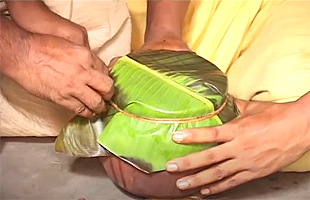
Under the supervision of Deula Karana, after the earthen pots were brought to the Anasara Pindi, Pati Mahapatra servitor took phuluri oil in three silver bowls and reform them. After samskara (reformation), the Daitapati servitors apply this oil on the body of the ailing Deities. Phuluri tela is applied to the Deities between the fifth day to seventh day of the Anasara period. After completion of the phuluri tela seva, the deities are offered solid food. Prior to this service, the deities consume liquid food as they are unwell. Phuluri tela Seva is one important part of the Gupta Riti (secret ritual) followed during the Anasara period.
What is Dasamula Modaka?
Dasamula Modaka is an Ayurvedic medicine. According to Ayurvedic methods and scriptures, dasamula modak is prepared for the Deities. It is prepared from herbal ingredients including Bela (wood apple), Gambhari (Gmelina arborea), Fanafana (Oroxylum indicum), Agabathu (Premna integrifolia), Krusnaparni (logopoides), Gokshura (Tribulus terrestris), Shalaparni (Desmodium gangeticum), Ankranty (Solanum xanthocarpum), Pateli (Stereospermum cheonoides) and Labingkoli (Solanum indicum) by the Raja Vaidya (Royal Physician). These ingredients are first dried and then hammered to make the powder. The powder is again filtered using plain cloth, placed in new wooden oven and seasoned with honey, sugar, milk cream, ghee, khua, bhang etc. After it is seasoned, it is placed on banana leaves and cooled. After it cools, modaka (round shape ball) has been prepared and kept in three kuduas (small earthen pots). The Raja Vaidya of the temple have been doing this service to the Lord for generations. They prepare 120 modakas for the Deities. After preparation, the modakas are taken to the temple immediately and are offered to the ailing Deities.
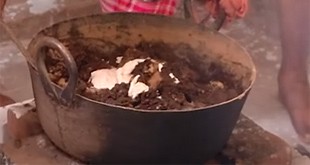
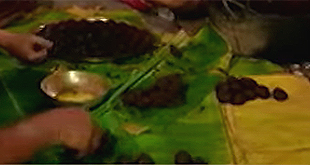
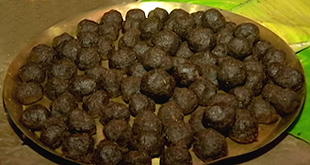
Dasamula Modaka is offered to the Deities on the Ekadasi tithi (eleventh day of Anasara period). The Gods are dressed in 'Rakta Bastra' and the dasamula modaka is offered. It is believed that dasamula modaka is the final remedy to completely cure the Deities.
What happens outside the Anasara Pindi during these two weeks?
During these days the Deities stay away from the public view and there is a need for substitute images for the public and to whom daily rituals can be offered at temple, so during this time three patta paintings of Lord Jagannath, Lord Balabhadra and Goddess Subhadra are worshipped in the temple. These patta paintings are known as 'Anasara patti' or 'Anavasara patti'. During Anasara period, the door of Patitapabana, the representative image of Lord Jagannath worshiped at the right side of Simha dwara (main entrance of the temple), is also closed. Besides the three main patta paintings, another small Anasara Pati is also prepared for Patitapabana and placed in front of the door for public view.
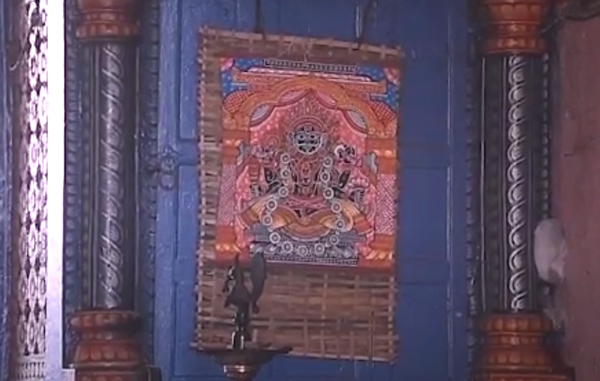
Mangala Aalati (Morning Prayer) of Anasara Pati of Patitapabana
Preparation of Anasara Pati begins on Jestha amavasya. On this day, the temple Chitrakaras receive pieces of cloth from the Jagannath Temple administration to use as pattas (canvas). A group of 10 to 15 artists, under the guidance of the chief artist, work on the paintings and paint the images of Shri Ananta Narayan, shri Ananta Basudev and Goddess Bhubaneswari. The three paintings represent the three Deities. Shri Ananta Narayan represents Lord Jagannath, Shri Ananta Basudev is Lord Balabhadra and Goddess Bhubaneswari represents Goddess Subhadra. Each patta painting is made on a cloth of 5.5 feet long and 4 feet wide. It takes 15 days to finish the Anavasara pati.
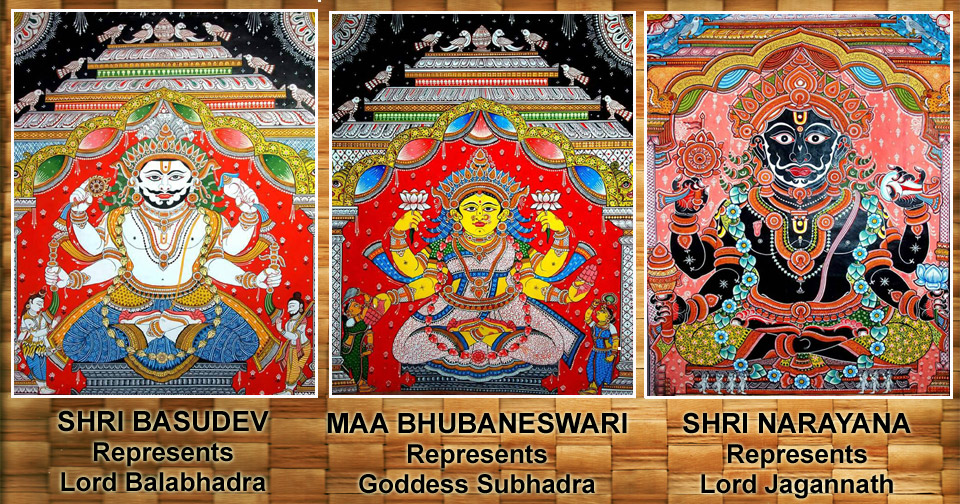
After completion, Priests from the Puri Jagannath Temple come to the chief artist's house with a garland (Aagyanmala). As per the tradition, special Puja is performed at his house and after the puja the Anasara Pati is rolled and tied with a piece of cloth and then carried to the Jagannath Temple by the Chitrakaras and temple Priests in a ceremonial procession accompanied by Hymn, bhajan, kirtana, mridanga, ghanta etc. A Tati (temporary partition wall made of Bamboo) is constructed in front of the original deities and on this tati the three Pata Paintings are placed as the representatives of the three Deities. Mangala Alati and Abakasha Niti rituals are performed near Patti Dians.
The three Pata Paintings represent the traditional form of Narayan, Basudev and Bhubaneswari with their usual attributes. Narayan is carrying Sankha, Chakra, Gada and Padma with his four arms. Basudev is holding Sankha, Gada, Hala and Musala. Bhubaneswari holds two lotuses.
On the Dwadasi tithi (twelfth day of Anasara period), the servitors of the temple will go in a procession to meet the Gajapati King of Puri to convey the good news about the recovery of the Deities. This ritual also known as the Raja Prasad Bije.
It is believed that visiting the temple of Alarnath of Brahmagiri to see Lord Alarnath is as good as seeing Lord Jagannath during the Anasara period, so thousands of devotees visit Brahmagiri to have a darshan of Lord Alarnath.
Loading Section...
Loading Section...